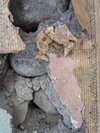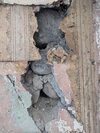Hi all,
I'm hoping for a bit of advice. We've just removed built-in a wardrobe, in a Victorian house, and behind a wooden false wall we've found the original walls to be in this state.
Does anyone know if this is normal construction for an internal wall in a Victorian property? They seem to be large stones rather than bricks.
I've absolutely no clue what to do next? Call a builder? Or a plasterer maybe? I'm worried this is a large, costly fix.
Thanks in advance, any advice/thoughts appreciated.
I'm hoping for a bit of advice. We've just removed built-in a wardrobe, in a Victorian house, and behind a wooden false wall we've found the original walls to be in this state.
Does anyone know if this is normal construction for an internal wall in a Victorian property? They seem to be large stones rather than bricks.
I've absolutely no clue what to do next? Call a builder? Or a plasterer maybe? I'm worried this is a large, costly fix.
Thanks in advance, any advice/thoughts appreciated.




